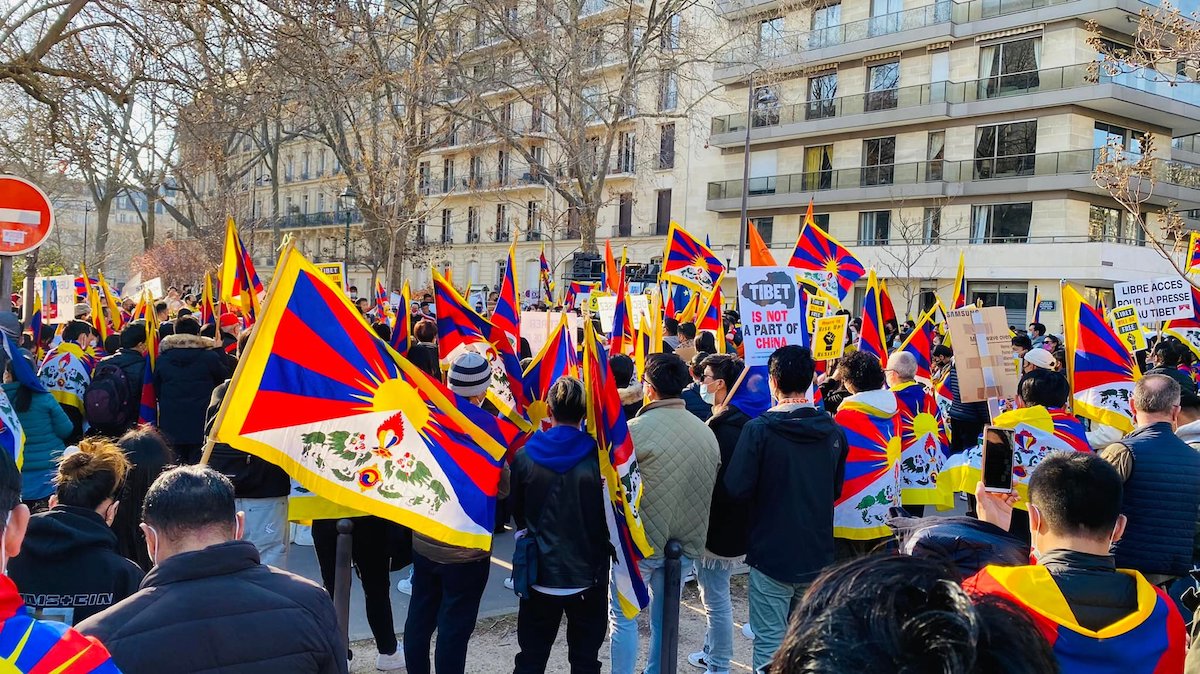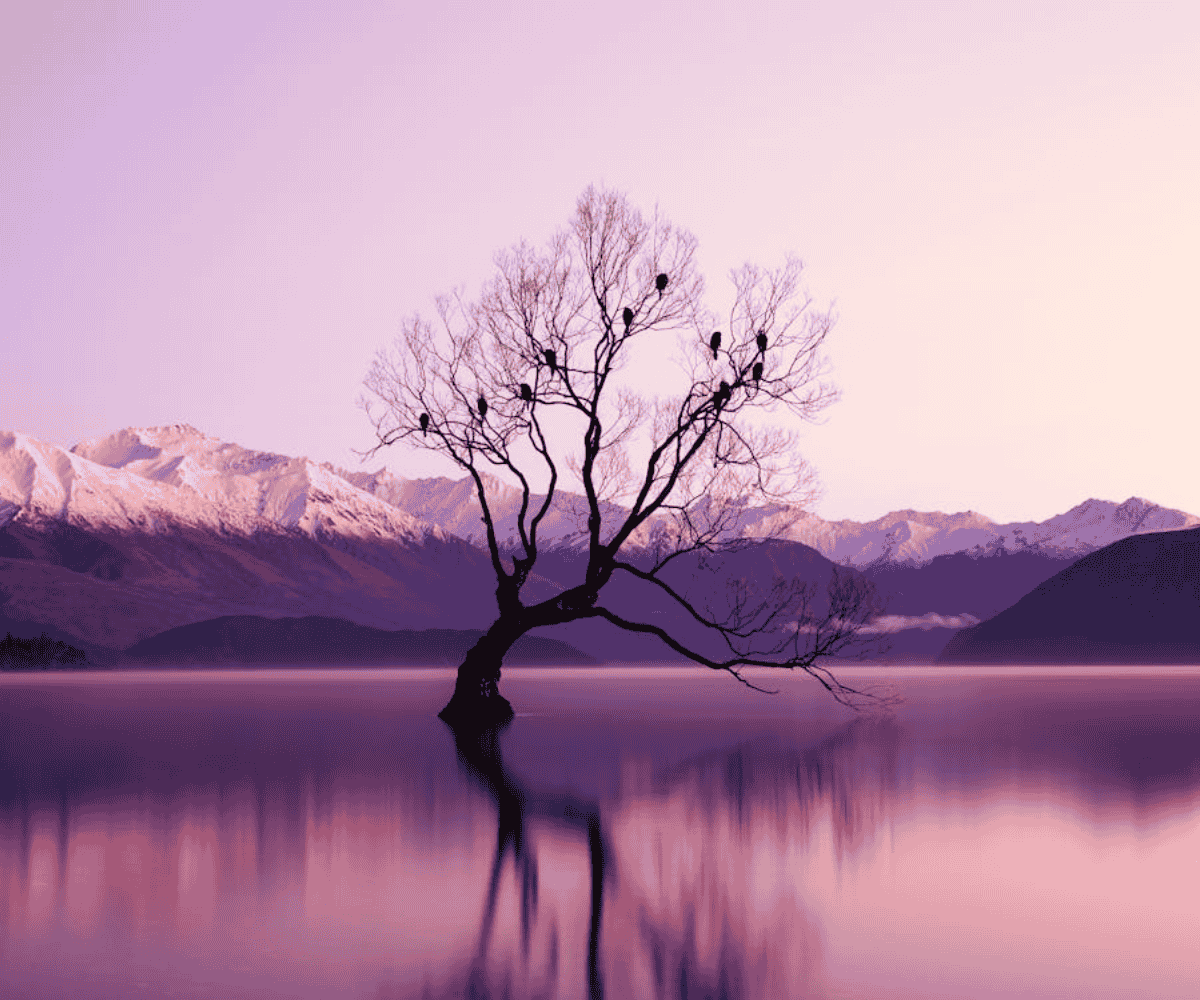I Never Gave Up on Dharma: Ngakpa Kalzang’s Journey from Tibet
Dhondop T. Rekjong tells the story of Ngakpa Kalzang, an exile of Tibet and experienced tantric Buddhist practitioner working as a landscaper on Canada's Vancouver Island. The post I Never Gave Up on Dharma: Ngakpa Kalzang’s Journey from Tibet...
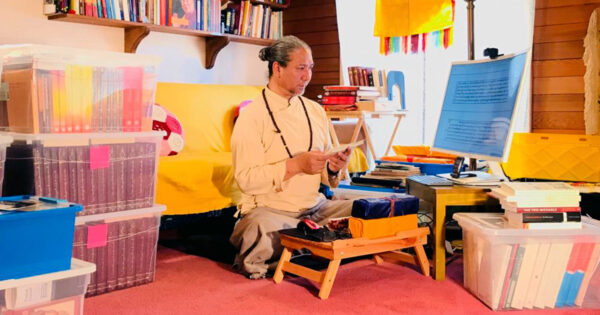
Dhondop T. Rekjong tells the story of Ngakpa Kalzang, an exile of Tibet and experienced tantric Buddhist practitioner working as a landscaper on Canada’s Vancouver Island, bridging a life of traditional knowledge and the modern world.
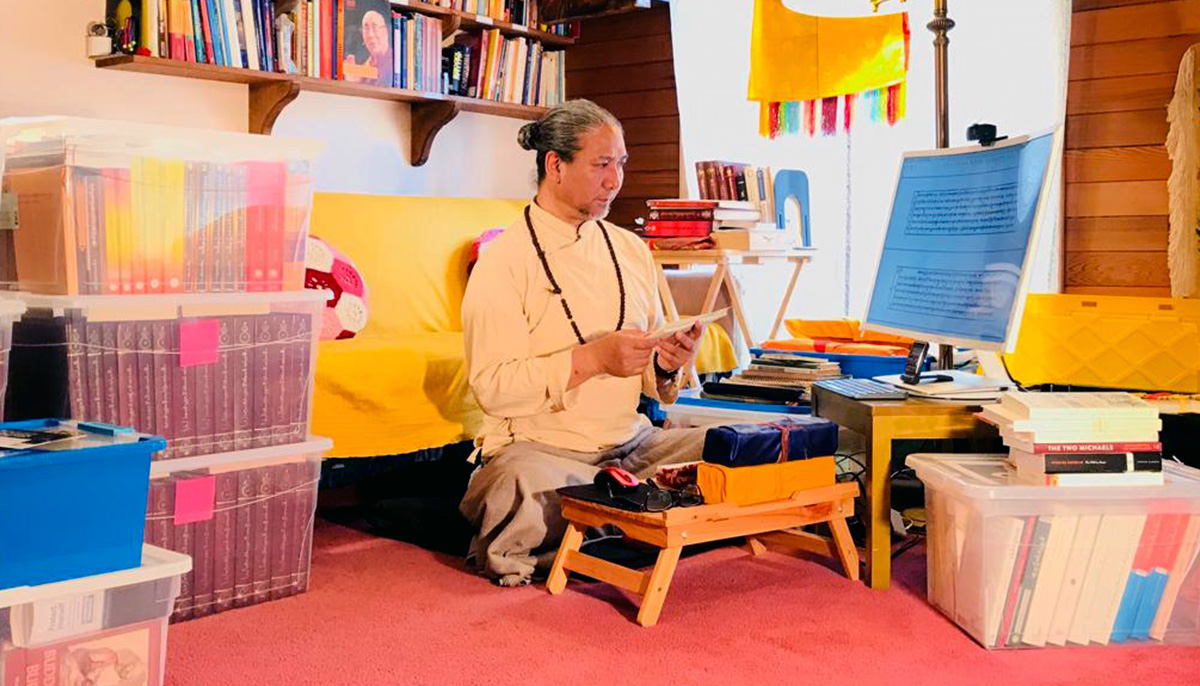
Ngakpa Kalzang at Thupten Choling center in Duncan, Canada, 2022.
Last summer, I visited Ngakpa Kalzang, an exile of Tibet and experienced practitioner of the Tibetan tantric Buddhism, at his home in Duncan, British Columbia, Canada. I set out to conduct a series of interviews with him about the history of the Nyingma monasteries of Amdo Rebgong, a place home to the largest tantric community on the Tibetan plateau. We were chatting in his living room one afternoon when he began talking about his dream of launching a dharma counselling project. I could see the excitement on his face, but something in his tone felt off. “When you don’t have great English skills and modern education,” he said, “it’s very difficult to use your traditional knowledge to make a living in the West.”
I still keep most of my books in the boxes, because we never know when we may need to move again. Nothing is permanent in exile.
Like Kalzang, there are unrecognized Tibetan intellectuals living in the West — practitioners who have been well trained in Tibetan Buddhism, but lack the platform and resources to share their knowledge. Their wealth of knowledge and teachings is often overlooked, but their life stories provide us with a window into the richness and lineage of Tibetan Buddhist practice in the modern world.
On the one hand, Kalzang is an experienced tantric practitioner, and on the other hand, he’s just a regular guy working as a landscaper on Vancouver Island. His life is stuck in bardo between traditional knowledge and the modern world.
Religious Life in Tibet
Ngakpa Kalzang was born to a tantric family in Amdo Rebgong, a community home to more than 1,900 tantric practitioners on the Tibetan plateau. He did his primary and second schools there, but wasn’t able to get into college. Consequently, in 1995, he decided to be a tantric practitioner at a local monastery. “On a basic level, to be a tantric practitioner,” he explains, “you have to complete the preliminary practice, to keep four primary vows, and to be able to recite guru puja.”
At one of the six Nyingma schools in Rebgong, Kyung-Gon monastery, Kalzang studied under two prominent masters: Dorje Kyab and Wangdi Gyal. Dorje Kyab taught him Words of My Perfect Teacher by Za Patrul Rinpoche, Ladder to Akanishta: Instructions on the Development Stage and Deity Yoga by Gyalwa Jigme Lingpa and other required rituals. Wangdi Gyal taught him Tibetan grammar and Root of the Way of Boddhisattva.
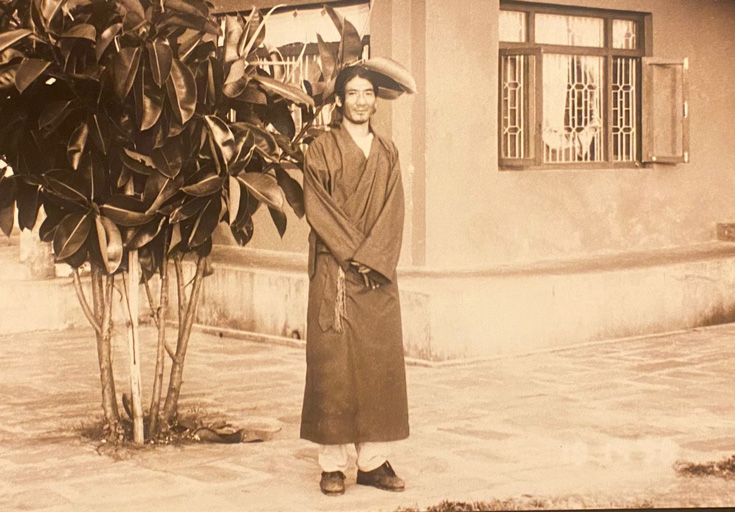
Kalzang at his monastery in Nepal, 1997.
Dorje Kyab regularly reminded Kalzang of the importance of studying and practicing the “development stage,” an important practice in the highest yoga tantra. The development stage’s purpose is to develop one’s impure vision into a pure primordial wisdom by visualizing all the qualities of a deity’s mind, speech, and body as indivisible from one’s own qualities. In the Nyingma tradition, Dza Patrul Rinpoche’s The Four Life-Binding Nails and Jigme Lingpa’s Ladder to Akanishta: Instructions on the Development Stage and Deity Yoga are among the most important texts on this practice.
“As a tantric practitioner,” says Kalzang, “grasping the development stage is beneficial to oneself and others. Without a deeper understanding of it, the outcome of ones’ practice will only produce conditioned merit.”
Kalzang’s teachers encouraged him to visit other Nyingma schools in Tibet, a tradition of Rebgong tantric communities. In particular, they have strong ties with Mindrolling and Dorjee Drak in central Tibet. Keeping with tradition, he left for Lhasa to study at Pema Kul in 1996.
In Lhasa, Kalzang had the opportunity to receive teachings from Dechen Youdon and Choenyi Rinpoche. Dechen Youdon, the daughter of Dudjom Rinpoche Jigdral Yeshi Dorjee, a renowned terton, or treasure revealer, yogi, and Dzogchen master, played an important role in preserving and disseminating her father’s lineage.
“It was the first time in my life that I received the empowerment of the Dudjom Tersar (new treasure),” Kalzang recalls. The Dudjom Tersar, the most comprehensive suite of treasure to be revealed by Dudjom Lingpa in nineteenth century, follows the three major traditions of Nyingma school including Jewel Treasure, Nyingma Gyubum, and Nyingma Kama.
While in Lhasa, Kalzang sought further studies at Choenyi Rinpoche’s monastery Lama Ling, but it didn’t work out. The Rinpoche was under Chinese surveillance, and the local government’s presence at the Rinpoche’s new stupa construction site was blatant.
“The situation was politically sensitive, and it wasn’t a great time for an outsider to study there,” Kalzang says. Instead, he travelled to India in 1997 to pursue his studies at Mindrolling under the guidance of Dungse Thinley Norbu. The journey from Lhasa to Nepal was long, taking nearly 18 days to reach Nepal. Everything went well until the last day.
“One night I had a dream,” he recalls, “In which our road was blocked by a huge landslide, and Dechen Youdon used her vajra to diminish it. Strangely enough, the next day our bus had an accident on the way to Kathmandu, but luckily no one was hurt. I had a special devotion to them after that dream and the accident.”
Kalzang had heard that it was difficult to find Tibetan books in India, so he carried several with him on the journey.
“At the outset, our guide warned me several times about the impossibility of carrying those books. He’d seen others who throw their books away on the road when they felt more fatigued as the days passed by,” he remembers. But Kalzang didn’t listen to his guide and carried the books all the way to Nepal — some have even made it to his home in Canada today.
Today, Kalzang keeps all his Tibetan books at the center where he teaches Buddhism on Sundays. There’s a small shelf that holds a few of the books, but most are kept in boxes on the floor. “I still keep most of my books in the boxes,” he says, “because we never know when we may need to move again. Nothing is permanent in exile.”
For Tibetans, escaping to India has several goals: to see His Holiness the Dalai Lama, seek political freedom, sustain a religious lineage, obtain modern education, and reclaim a free Tibet. Kalzang chose all of these when he decided to leave Tibet for India.
Exile in India
When he arrived at the Tibetan reception center in Dharamsala, Kalzang expected to join Mindrolling monastery. He was deeply saddened to discover that, unlike in Tibet, he needed to be ordained in order to join the monastery. Kalzang spent nearly a month at the reception center without a firm plan in place.
“I was truly sad that I was unable to find a place for my tantric studies. I even thought that maybe I had made a mistake coming to India.”
Kalzang wanted to continue his studies, but couldn’t find a prominent center, and was already well trained in the ritual studies available. “I couldn’t stay at the reception center forever,” he says. “I decided to go to the Tibetan transit school.” Unfortunately, he fell ill while at school and had to drop out.
“Looking back, dropping out of the school was a good karmic decision. If I stayed at the school, I might have chosen a different career path and may even have lost my dharma studies,” he says.
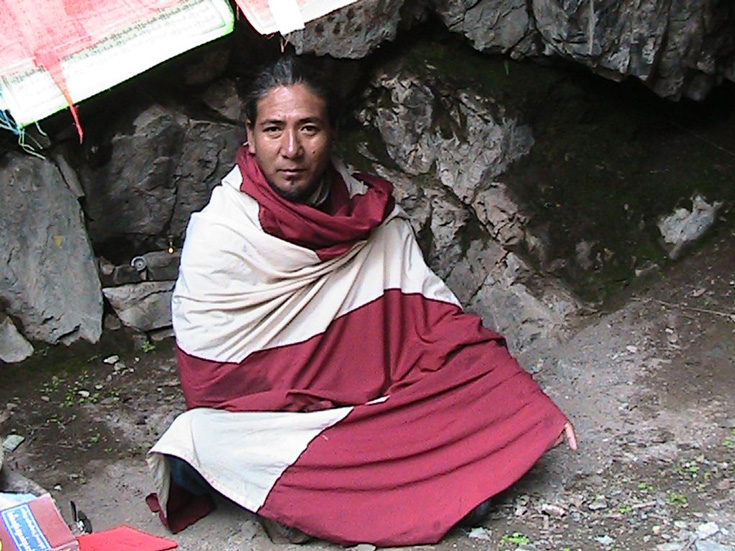
Kalzang at Guru meditation cave in Rebgong, Tibet.
While he was waylaid in Dharamsala, a friend who had recently returned from Nepal informed him of a tantric monastery that looked like a perfect place to continue his studies. He also brought good news that the Lama of the monastery was coming to Dharamsala to meet with His Holiness the Dalai Lama. Fortunately, Kalzang was able to obtain a private audience with the Lama, who turned out to be the Nyingma scholar Khetsun Sangpo Rinpoche, who had taught Tibetan Buddhism and history at Tokyo university for a decade, and was also the author of the 12 volumes of The Biographical Accounts of Indian and Tibetan Buddhist Masters.
Khetsun Sangpo Rinpoche confirmed that Kalzang could join the monastery. “I was overjoyed to see this great Nyingma master,” he recalls, “It finally felt like my dream of coming to exile wasn’t wasted.”
Exile is a sort of bardo in which Tibetans need to rebuild everything, beginning again in the middle. Such a life seemed to be destined for Kalzang too.
Buddhist Studies in Nepal
Kalzang left for Nepal to join Ngagyur Shedrup Dojo Ling monastery, the first Nyingma shetra (scriptural monastic college) in exile, founded by Dudjom Rinpoche in 1972. Khetsun Sangpo Rinpoche was Dudjom Rinpoche’s disciple. His first sight of the monastery amazed him deeply. There was a Shitro Mandala in the center hall, with Kangyur and Tangyur scriptures alongside. No statues were to be found, and the monastery didn’t even have a fence. It was built only for study.
“Khetsun Sangpo Rinpoche was 76 years old when I met him,” Kalzang remembers. “I was advised not to worry about food, clothes, and shelter. He emphasized that the only purpose of the monastery is to study — nothing else.”
Khetsun Sangpo Rinpoche’s advice tremendously impacted him. “From the beginning, my lama told me that I need to pay more attention to Paramita and Madhyamaka in order to have a better understanding of Tantra. He also asked me to study Abhidharma. My lama was totally against going for retreat before finishing all the major treatises of Sutra and Tantra,” he says.
As long as you don’t give up on dharma, dharma will be always with you.
Kalzang studied at the monastery for eight years, completing all the courses of the 13 major treatises of Nyingma tradition. He especially studied Paramita and all the tantric courses from Khetsun Sangpo Rinpoche. These included Guru Rinpoche’s The Oral Instruction of Garland of Views, Rongzom Chokyi Zangpo’s Establishing All Appearances as Divine, Jigme Lingpa’s The Treasury of Precious Qualities and The Commentary of Magical Secret Nucleus by Rongzom, Longchenpa Rabjam, and Lochen Dharmashri.
“Looking back, I think I had the best education at the monastery,” Kalzang says. “Not only studying all the required tantric courses, but also receiving transmissions, instructions, and empowerments from some great Nyingma masters.”
In Tibetan Buddhism, teachings are linked to either empowerment or transmission, or to instruction of a guru. Without one of them, the teaching is not considered authentic. In other words, lineage is the spine of Tibetan Buddhism. Kalzang received all the instructions of The Magical Secret Nucleus from Khenpo Gelek Tenzin and Taklung Tsetral Rinpoche. The former was Khenpo Petse Rinpoche’s student and the latter the head of Dorjee Drak monastery in Tibet.
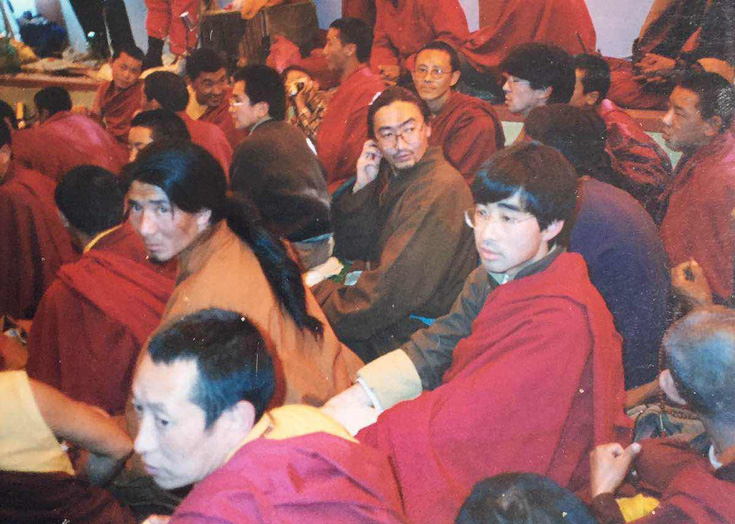
Kalzang receiving teachings of Northern Treasury from Taklung Tsetral Rinpoche, Nepal, 1998.
In his final years at the monastery, Kalzang became his lama’s main assistant, and often went for evening walks with him. “My lama loved to go out for evening walks. I received some money from some Japanese students studying at our monastery and went to Kathmandu to order a customized foldable chair for my lama, which he loved to use on his walks,” he says.
For Kalzang, these walks were precious opportunities to ask questions of his lama. “After almost five years of studying at the monastery, I asked him whether I should go for a retreat. He said it is very important to excel at listening and contemplating before meditating or going for any retreats. I took that advice to heart.” he says.
After finishing his studies, Kalzang considered going on retreat at various sacred sites in India and Nepal until he received an invitation to travel to Canada.
In exile, even after significant achievements, the future remains uncertain because your accomplishments may be undervalued or considered useless in a new country.
New Life in Canada
In 2004, Kalzang was invited to be the resident teacher for the Thubten Choling center in Duncan, British Columbia for six months.
“I was happy about the invitation, but soon felt that I didn’t know enough English to teach Buddhism to my students,” he says. However, his student’s tolerance and willingness to learn encouraged him to continue his teachings.
“My students never said that they didn’t understand me. I am grateful to my former and current students for letting me use my unpolished English,” he says.
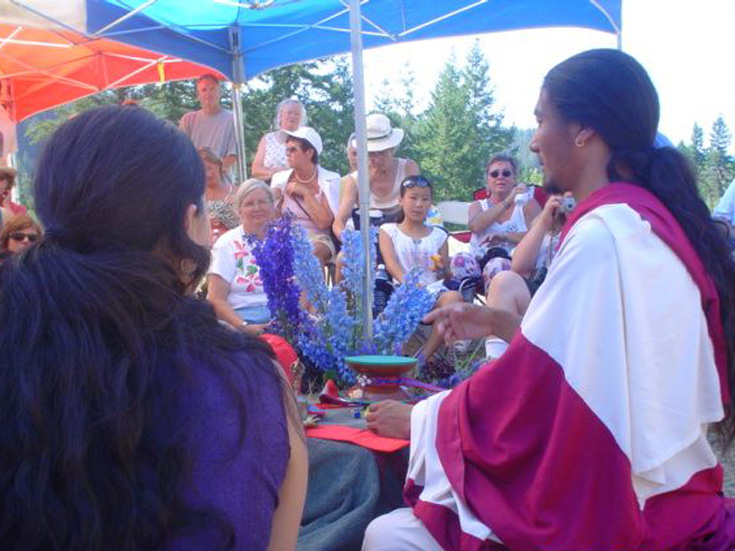
Kalzang teaching in British Columbia, 2004.
When he started teaching in Canada, he was asked to teach the Thirty-seven-fold Practices of a Bodhisattva by Gyalse Thokmey Sangpo. “When teaching this precious book, I strongly felt that there was a gap between what I know and what I can describe. So, my best friend’s wife, Dolma, interpreted for me. Her help was invaluable.”
Kalzang taught the book based on three premises: a general Buddhist perspective, a practitioner’s perspective, and a contemporary social perspective. There is a concept of inner, outer, and secret teachings in Tantric scholasticism which presents the worldly, doctrinal, and visionary levels of teachings, he employed this method. “Dolma eventually enrolled at the University of British Columbia to pursue her nursing degree, and I was on my own. So, I had to improve my English in order to teach Buddhism.”
Kalzang began by reading the Dalai Lama’s books in English because they were easy for him to understand. Through reading His Holiness’s books, he realized that Buddhist teaching is about making wisdom accessible to others. “Later, I also started going to all the major teachings of the Dalai Lama in India and North America,” he added. Considering the difficulties, he endured while teaching Buddhism in a new country, Kalzang feels his situation mirrors that of the great Indian master Smrtijana, who came to Tibet in the 10th century, but spent most of his life as a shepherd for a Tibetan family in the Tsang Tanak area. One day the master engraved a poem on the door header of his host’s house:
The moon with star garland;
Without seeing it travelling in the night sky;
Instead, saying the moon is in the crystal lake;
The reflection as moon is a delusion.
—Thon Mi’s Counsel by Tseten Zhabdrung, Qinghai Nationalities Publishing House, 1980
“The Indian master’s story reminds me of the difficulties that someone has to endure when language skill is the lifeline for everything in a foreign land,” he says.
“In 2006, I decided to stay in Canada,” he tells me. “I had to find a job to make a living, and started doing landscaping with some friends. I’m still doing it.”
Landscaping has been Kalzang’s main source of income for more than a decade, but he’s never stopped his Buddhist teachings and practices. Today, he teaches Buddhism at Thubten Choling for an hour every Sunday, but his personal practice is a daily endeavor.
Kalzang never misses his morning and evening prayers and practices. They are the only way he can keep his studies and practices alive in a foreign land, where he doesn’t have the privilege, power, or platform to reach wider audiences.
“Every morning before leaving for work, I wake up at 6 a.m. and do my morning prayers. I do the the five stakes of the Northern Treasures, which entails the stake of refuge taking, the stake of generating bodhisattva, the stake of treasure mandala, the stake of Vajrasattva, and the stake of guru yoga.” He remains serious about his morning practices.
At the end of his workday, either before or after dinner, Kalzang practices Yidam Dorjee Trolo, as he received it from Dechen Youdon in Lhasa, many years ago. Sometimes, he practices The Trilogy of Natural Freedom by Longchenpa as he received that instruction from his lama.
Even after 17 years in Canada, Kalzang is determined to share his Buddhist knowledge and wisdom. He strongly believes that Buddhist practice can build foundations for our happiness at large and aims to keep his traditions alive in the modern world. “In those years, I met many veterans from the Second World War, and they told me that they still have regrets about what they did,” he tells me, “Having regret is a good sign of recognizing one’s qualities. In Buddhism, to appreciate what we did right and feel regret for what we did wrong is the right path to happiness.” He hopes that some of the veterans found his insight helpful.

Kalzang working as a landscaper in British Columbia, 2018.
There are many others like Kalzang — experienced practitioners and scholars dwelling largely unrecognized in the West.
Kalzang is currently working on a new website, where the vision, mission and goals of his dharma counselling project will be introduced. “My website is a small step towards introducing my dharma counselling project to others,” he explains, “I want to keep things simple for myself and others on this new journey.” The goal of his dharma counselling is to be available for those trying to heal from emotional disturbance, to help them to find self-confidence and overcome insecure feelings, and to guide them to reconnect to their personal code of strength and well-being.
Whether his dharma counselling project finds a strong root or not, his philosophy remains simple.
“As long as you don’t give up on dharma, dharma will be always with you, within you, and around you.”

 Tekef
Tekef 










